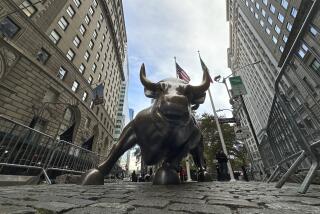Past Comebacks
- Share via
The 337.17-point gain in the Dow Jones industrial average Tuesday falls into a pattern set by some of the index’s other notable nose dives.
Monday’s record 554.26-point drop could be a major, and overdue, correction, or the opening movement of a developing bear market.
The gain Tuesday amounted to just 4.7% of the Dow index’s value.
A look at the days following the previous top five historic drops shows an almost immediate rebound effect within days, sometimes of historic proportions.
****
1987
1. The previous record one-day drop was set Oct. 19, 1987, a 508-point slide, or 22.6% of the index’s value.
The stunning rally the next day lifted the Dow 102.27 points, or 5.9%.
daily close. Dow Jones average of 30 industrial stocks
****
1929
The infamous Crash of 1929 began with a 12.8% drop on Oct. 28 (2) followed by an 11.7% drop the next day (3). However, the next two days saw gains of 12.3% and 5.8%, respectively. The drop on Nov. 6--until Monday the fourth largest in history at 9.92% (4)--was followed several days later by a brisk rally.
In the late 19th and early 20th centuries, stocks were traded Monday through Saturday. In the fall of 1929, trading was often halted for a day or two-the circuit breakers of their day.
****
1899
The Dow of the late 19th century traded below 100, so a 5- or 6-point drop was disastrous. On Monday, Dec. 18, 1899, the market tumbled a whopping 5.57 points, or 8.72% (5). The next day, it regained an equally notable 4.7%.
The Crash of 1899 didn’t usher in a prolonged bear market. A year later the Dow was trading around 70.
Researched by JANET LUNDBLAD and VICKY McCARGAR / Los Angeles Times
More to Read
Inside the business of entertainment
The Wide Shot brings you news, analysis and insights on everything from streaming wars to production — and what it all means for the future.
You may occasionally receive promotional content from the Los Angeles Times.










